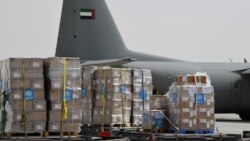Iran's Deputy Health Minister Alireza Raeesi says 1501 Iranians have tested positive for coronavirus (COVID-19) and at least 66 have died until Monday morning March 2.
Raeesi told reporters in Tehran that the new figure includes 523 new cases and that the death toll has risen by 12 during the past day. He also told Mehr news agency that 291 patients previously in hospitals, have recovered.
Many in Iran, however, challenge the figures announced by the government and believe the contagion has spread much wider and the death toll is more than what the government says. With reports of more deaths emerging, the figures announced by officials get closer to the ratios registered between deaths and infections in China.
Previously, the death toll in Iran was much higher compared with the official number of infected cases, reaching to more than 10 percent. The new ratio is less than 3 percent.
Dr. Abdolreza Fazel, head of the Health Authority in Golestan Province says 594 patients have been diagnosed with Coronavirus in that province alone. He explains in great detail how the virus affects and damages people's lung.
Gholam Ali Jafarzadeh Imanabadi, a member of Iran's parliament from Rasht in northern Iran says the situation in his constituency, Gilan Province, is critical and all the hospitals in the provincial capital Rasht are filled with coronavirus patients.
Imanabadi said figures released by the government is "something like a joke." The lawmaker urged the media to pay more attention to Gilan as the situation there is even more critical than Qom which is said to be where the contagion originated.
He said disinfection started 10 days after the outbreak and after hundreds of people were hospitalized. Imanabadi added that there is a serious shortage of equipment in hospitals in Gilan. Many of the hospitals are overcrowded and Razi Hospital has announced that it can accept no more patients.
The lawmaker said officials don't tell the truth about the outbreak and the death toll is much higher than what the authorities say. He added that burial of those who died of coronavirus has taken place in a non-hygienic way in the villages. The causes of many deaths have not been registered, he said.
He also criticized officials for not telling the people about the serious threat to public health. He said some 700,000 Iranians have traveled to Gilan from the other parts of the country since the outbreak started.
During the past days, other members of the Iranian parliament, including Ahmad Amirabadi Farahani, MP for Qom, have also accused the government of concealing facts and figures about the outbreak.
Farahani who has himself been tested positive for the virus said that at least ten people die in Qom every day as a result of the virus.
In the meantime, there have been many complaints about discrimination in the allocation of medical services to various groups of people. The cause of death of a 25-year old nurse in Lahijan in Gilan Province has been established as coronavirus, seven days after her death. Earlier, the cause of her death was officially announced as "flu-like symptoms."
This comes while well-connected individuals including Farideddin Haddad-Adel, a member of Supreme Leader Ali Khamenei's family, had their test immediately after they feared they might have caught the virus.
Another MP from Gilan, Mohammad Hossein Qorbani complained on Sunday that samples are being sent to Tehran and the results arrive with long delays.
Health Minister Saeed Namaki said on Tuesday that the police are going to control traffic to and from the most seriously affected areas, however, there is still no news about imposing quarantine on badly hit places such as Qom and Rasht.
Meanwhile, as it was found that many Chinese patients contracted coronavirus at local medical centers, Gilan Province authorities have shut down private sector medical centers and clinics to avoid exposure to the virus in waiting rooms.
Meanwhile, the Rouhani administration's spokesman, Ali Rabiei said on Monday that Iranians will have to face another two difficult weeks before the impact of coronavirus begins to diminish in warmer weather before the Iranian New Year Nowrouz in late March. However, experts say the rise in temperature does not affect coronavirus.






